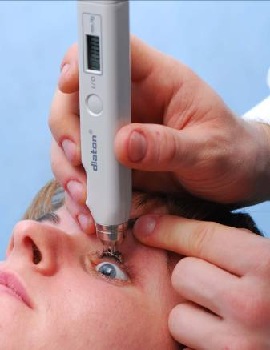Intraocular pressure
Pressure exerted by the fluids inside the eye
Intraocular pressure (IOP) is the fluid pressure inside the eye. It is an important aspect of eye health and is a critical factor in the diagnosis and management of glaucoma.
Physiology[edit | edit source]
Intraocular pressure is determined by the balance between the production and drainage of aqueous humor, the clear fluid inside the eye. The ciliary body produces aqueous humor, which flows through the pupil into the anterior chamber of the eye and drains out through the trabecular meshwork and Schlemm's canal.
Measurement[edit | edit source]
Intraocular pressure is measured using a device called a tonometer. There are several types of tonometers, including the Goldmann applanation tonometer, which is considered the gold standard, and the non-contact tonometer, which uses a puff of air to measure pressure. The Diaton tonometer is a transpalpebral tonometer that measures IOP through the eyelid.
Normal Range[edit | edit source]
The normal range for intraocular pressure is typically between 10 and 21 mmHg (millimeters of mercury). However, what is considered "normal" can vary between individuals, and some people with pressures outside this range may not have any eye disease.
Clinical Significance[edit | edit source]
Elevated intraocular pressure is a major risk factor for glaucoma, a group of eye conditions that can lead to optic nerve damage and vision loss. Monitoring and managing IOP is crucial in patients with glaucoma to prevent progression of the disease.
Factors Affecting Intraocular Pressure[edit | edit source]
Several factors can influence intraocular pressure, including:
- Age: IOP tends to increase with age.
- Genetics: Family history can play a role in IOP levels.
- Medications: Certain medications can increase or decrease IOP.
- Time of day: IOP can fluctuate throughout the day.
Management[edit | edit source]
Management of elevated intraocular pressure often involves medications such as prostaglandin analogs, beta blockers, or carbonic anhydrase inhibitors. In some cases, surgical interventions like trabeculectomy or laser therapy may be necessary.
Also see[edit | edit source]
| Eye diseases and disorders | ||||||||||
|---|---|---|---|---|---|---|---|---|---|---|
This eye diseases related article is a stub.
|
This article is a ophthalmology stub. You can help WikiMD by expanding it!
Transform your life with W8MD's budget GLP1 injections from $125
W8MD offers a medical weight loss program NYC and a clinic to lose weight in Philadelphia. Our W8MD's physician supervised medical weight loss centers in NYC provides expert medical guidance, and offers telemedicine options for convenience.
Why choose W8MD?
- Comprehensive care with FDA-approved weight loss medications including:
- loss injections in NYC both generic and brand names:
- weight loss medications including Phentermine, Qsymia, Diethylpropion etc.
- Accept most insurances for visits or discounted self pay cost.
- Generic weight loss injections starting from just $125.00 for the starting dose
- In person weight loss NYC and telemedicine medical weight loss options in New York city available
- Budget GLP1 weight loss injections in NYC starting from $125.00 biweekly with insurance!
Book Your Appointment
Start your NYC weight loss journey today at our NYC medical weight loss, and Philadelphia medical weight loss Call (718)946-5500 for NY and 215 676 2334 for PA
Search WikiMD
Ad.Tired of being Overweight? Try W8MD's NYC physician weight loss.
Semaglutide (Ozempic / Wegovy and Tirzepatide (Mounjaro / Zepbound) available. Call 718 946 5500.
Advertise on WikiMD
|
WikiMD's Wellness Encyclopedia |
| Let Food Be Thy Medicine Medicine Thy Food - Hippocrates |
Translate this page: - East Asian
中文,
日本,
한국어,
South Asian
हिन्दी,
தமிழ்,
తెలుగు,
Urdu,
ಕನ್ನಡ,
Southeast Asian
Indonesian,
Vietnamese,
Thai,
မြန်မာဘာသာ,
বাংলা
European
español,
Deutsch,
français,
Greek,
português do Brasil,
polski,
română,
русский,
Nederlands,
norsk,
svenska,
suomi,
Italian
Middle Eastern & African
عربى,
Turkish,
Persian,
Hebrew,
Afrikaans,
isiZulu,
Kiswahili,
Other
Bulgarian,
Hungarian,
Czech,
Swedish,
മലയാളം,
मराठी,
ਪੰਜਾਬੀ,
ગુજરાતી,
Portuguese,
Ukrainian
Medical Disclaimer: WikiMD is not a substitute for professional medical advice. The information on WikiMD is provided as an information resource only, may be incorrect, outdated or misleading, and is not to be used or relied on for any diagnostic or treatment purposes. Please consult your health care provider before making any healthcare decisions or for guidance about a specific medical condition. WikiMD expressly disclaims responsibility, and shall have no liability, for any damages, loss, injury, or liability whatsoever suffered as a result of your reliance on the information contained in this site. By visiting this site you agree to the foregoing terms and conditions, which may from time to time be changed or supplemented by WikiMD. If you do not agree to the foregoing terms and conditions, you should not enter or use this site. See full disclaimer.
Credits:Most images are courtesy of Wikimedia commons, and templates, categories Wikipedia, licensed under CC BY SA or similar.
Contributors: Kondreddy Naveen, Prab R. Tumpati, MD




